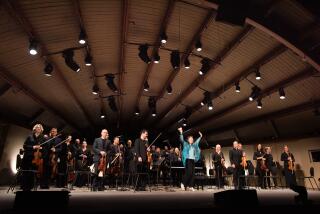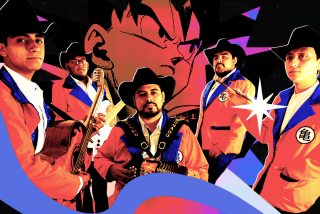Odori Festival Comes to Little Tokyo : Japanese Troupe Steps Forward With Folk Traditions
- Share via
TOKYO — “In Europe, the folk dances have all died away. But in Japan, these dances are still alive,” says Hideo Kimura, founder of the Japan Folkloric Art Dance Troupe, which will present the Odori (dance) Festival of Japan at the Japan America Theatre in Little Tokyo on Saturday, with performances at 2 and 8 p.m.
Dancing their way from Schenectady to Kalamazoo and points west on their U.S. tour, the troupe of 32 dancers and musicians will present folk dances that, unlike European dances created to entertain the participants themselves, were choreographed for an audience--the Shinto gods of nature. Successful performances could bring a good harvest, drive away vermin, or calm down the winds during typhoon season.
Although Japanese villages still retain their local guardian gods, “today, these dances are performed for tourists, not for deities,” Kimura says.
Sitting in a Tokyo coffee shop, dressed in a standard issue, blue-striped Japanese “salaryman” suit, Kimura, 72, seems an unlikely impresario. Yet, show business is in his blood, he says.
One of his grandfathers was a village chief who taught him folk songs; the other was a teacher of the traditional Lion Dance. When Kimura survived the atomic blast in Hiroshima in 1945, it seemed natural to express his deep feelings about the event by producing his first dance piece--”No More Hiroshimas”--featuring his wife and her sister, both of whom were modern dancers.
In 1962, when Kimura founded the Japan Folkloric Art Dance Troupe, the country’s folk dances, handed down from generation to generation, were dying out, as Japan changed from an agricultural to an urban society.
“After the war, all the great folkloric dance troupes from around the world performed here and were a great success. I thought Japan should have its own company,” Kimura says. “Also, I wanted to give a new life to these traditions.”
In 1963, subsidized by a government grant, a team of 150 researchers, including folklorists, ethnomusicologists, choreographers and composers, went out into the field to document Japan’s folk dances. It turned out to be a monumental task. Because the country is so mountainous, over the centuries villages developed their own unique cultures and traditions. The researchers found more than 3,000 different dances.
“Some of the dances were created as the only entertainment available during the long snowy winters up north, but most were religious in nature,” Kimura says.
Religious and quasi-religious festivals--from Shinto ceremonies to annual Buddhist “O-Bon” summer festivals welcoming home deceased ancestors--are still popular in Japan. And these dances are still being performed.
“Unlike the Europeans who must re-create their dances out of limited material, we only deal with dances that are still danced. We don’t re-create from records.
“The choreography is original. Of course, repetition and monotony are characteristic of these kinds of folk dances, so we have adapted them for the stage. We cut the repetition and sometimes we speed the dance up. Or we’ll change the music. But never the choreography.
“We are also completely faithful to the design of the original props and costumes, although we will enlarge them or adjust the colors and materials to make the transition from natural light to theatrical lighting.”
Five years after its founding, the company made its first overseas appearance at the 1967 Montreal Exposition. Since then, they have taken Japan’s folk dances to audiences in more than 50 countries.
“We’re more popular outside of Japan than inside,” Kimura says. “Japanese people today don’t have any feeling for the traditions of Japan. The new generation is more interested in new and foreign things. They are becoming foreigners to their own culture.”
The audience is not the only problem. Japanese dancers today prefer ballet and American jazz dance to folk dancing. And, as today’s Japanese musicians are trained in Western music, it is difficult to find performers to play traditional Japanese music and instruments with skill.
Kimura pours himself another cup of English tea from the porcelain pot on the table in front of him. It is lunchtime and the coffee shop is filled up with blue-suited men who order sandwiches and pastas and hamburger steaks.
“That’s why I’m doing all this,” Kimura says. “To show them. The new generation.
“And they will return to Japanese culture eventually.
“Historically, the Japanese, after exploring other cultures, whether it is China or Korea or America, have always returned to Japan.”
More to Read
The biggest entertainment stories
Get our big stories about Hollywood, film, television, music, arts, culture and more right in your inbox as soon as they publish.
You may occasionally receive promotional content from the Los Angeles Times.










